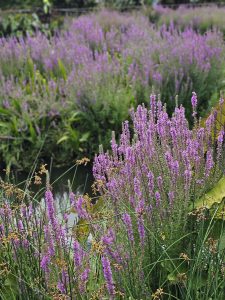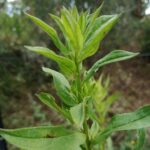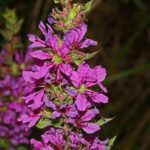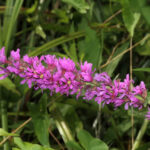Gardening with Indigenous Plants
Indigenous Plant Use
Identification & Control of Common Weeds
| Botanical Name: | Lythrum salicaria |
| Common Name: | purple loosestrife |
| Sold As: | Tube ($2.00) |
| Plant Type(s): | Ground Cover (up to 30 cm), Low Growing Shrub (30 cm to 1 m), Butterfly Attracting, Insect Attracting, May not be Indigenous to Whitehorse, Aquatic |
| Growing Conditions: | Full Sun
Moist, Wet, Boggy, Poorly Drained, Aquatic |
| Size (HxW): | 1-2 m x 1 m |
| Foliage: | Pairs of oval to lance-shaped leaves to 75mm long, pointed at the tip. |
| Flowers: | Clusters of tubular, purple to magenta petalled flowers borne in long spikes at the end of stems. Flowers from November to March. |
| General Comments: | Hates dry soil. This is an ideal plant to grow in aquatic environments. Erect annual herb with tuberous roots, plants usually die down in winter but bounce back in spring. Both food for caterpillars and nectar for butterflies. A very showy plant for borders, bog gardens and around water edges such as ponds or pools. Stems should be cut back to roots after flowering. Plant dies back over summer. A most attractive wetland plant with well displayed flowers. Grow in and beside shallow ponds. |
 Further Information: |
|
| Plant Propagation: | Propagation is by root division or seed, and self-sown seedlings often appear in open ground. If desired, cuttings may be taken from non-flowering laterals in midsummer and struck outdoors in shade. Cuttings rapidly produce roots. |






